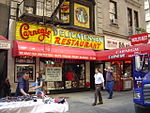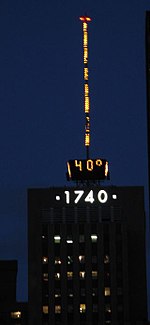A7 (bar)
A7 was a club in New York City that between 1981 and 1984, was one of the main locations of the New York hardcore scene. The tiny space was located on the southeast corner of East 7th Street and Avenue A in Manhattan's East Village. The venue hosted fast punk bands such as The Stimulators or The Violators, and slowly a hardcore scene of initially about 100 persons formed around the club which spawned bands like The Abused, Agnostic Front, Antidote, Cause for Alarm, Cro-Mags, Heart Attack, Kraut, The Mob or Urban Waste who played the A7 regularly, some of them weekly. Although the venue were putting on performances from lesser known New York punk rock and hardcore bands like False Prophets, it became the scene's unofficial headquarters of the scene after Bobby Steele began performing at the venue due to him being banned from CBGB and Max's Kansas City. It also played host to a fertile jazz and reggae scene during the 1980s.The success of the club led to the owner opening 2+2 club on the intersection of East Houston Street and 2nd Avenue in the summer 1982. This venue was larger and would host performance by bigger performances.
Excerpt from the Wikipedia article A7 (bar) (License: CC BY-SA 3.0, Authors).A7 (bar)
7th Avenue, New York Manhattan
Geographical coordinates (GPS) Address Nearby Places Show on map
Geographical coordinates (GPS)
| Latitude | Longitude |
|---|---|
| N 40.7639 ° | E -73.9817 ° |
Address
7th Avenue 846
10019 New York, Manhattan
New York, United States
Open on Google Maps









